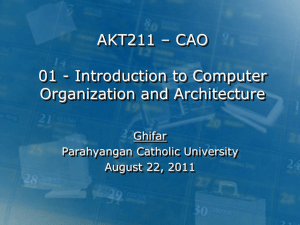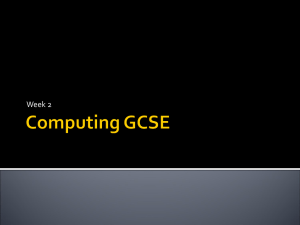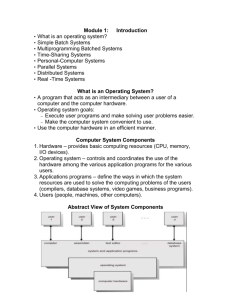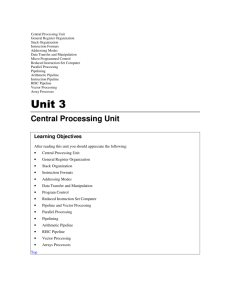Unit II
advertisement
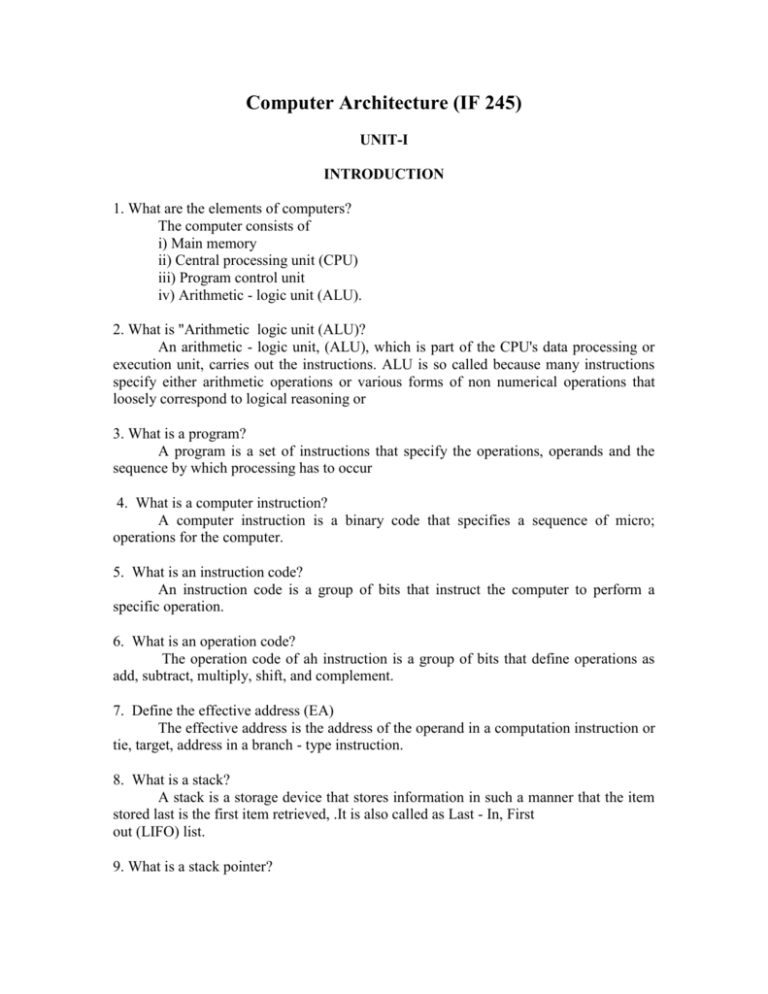
Computer Architecture (IF 245) UNIT-I INTRODUCTION 1. What are the elements of computers? The computer consists of i) Main memory ii) Central processing unit (CPU) iii) Program control unit iv) Arithmetic - logic unit (ALU). 2. What is "Arithmetic logic unit (ALU)? An arithmetic - logic unit, (ALU), which is part of the CPU's data processing or execution unit, carries out the instructions. ALU is so called because many instructions specify either arithmetic operations or various forms of non numerical operations that loosely correspond to logical reasoning or 3. What is a program? A program is a set of instructions that specify the operations, operands and the sequence by which processing has to occur 4. What is a computer instruction? A computer instruction is a binary code that specifies a sequence of micro; operations for the computer. 5. What is an instruction code? An instruction code is a group of bits that instruct the computer to perform a specific operation. 6. What is an operation code? The operation code of ah instruction is a group of bits that define operations as add, subtract, multiply, shift, and complement. 7. Define the effective address (EA) The effective address is the address of the operand in a computation instruction or tie, target, address in a branch - type instruction. 8. What is a stack? A stack is a storage device that stores information in such a manner that the item stored last is the first item retrieved, .It is also called as Last - In, First out (LIFO) list. 9. What is a stack pointer? The register that holds the address for the stack fs called stack pointer (SP) because its value always points at the top item in the stack. 10. What are the operations of a stack? The two operations of a stack are i) Insertion of items ii) Deletion of items 11. What is push and pop? , The operation of insertion is called push because it can be thought of as the result of pushing a new item on top. The operation of deletion is called pop because ft can be thought of as the -result of removing one item so that the stack pops up. 12. What are the types of stack? Stack can be of two types. These are 1. Register stack 2. Memory stack 13. What is the polish notation? The polish mathematician Lukasiewicz showed that arithmetic expressions can be represented in prefix notation. This representation often referred to as polish notation, places the operator before the operands. 14. What is the reverse polish notation (RPN)? The postfix notation, referred to as reverse polish no the operator after the operands. 15. What is an instruction format? The format of an instruction is usually depicted in a symbolizing the bits of the instruction as they appear in memo control register. The bits of the instruction are divided into groups called fields 16. What are the fields of an instruction format? The most common fields found in instruction formats are 1. An operation code field that specifies the operation to be performed. 2. An address field that designates, a memory address or register. 3. A mode field that specifies the way the operand or the effective address is determined. 17. What is a register address? A register address is a binary number of kbits that defines one of 2k registers in the CPU 18) What are the types of CPU organizations? Three types of CPU organizations are: 1. Single accumulator organization. 2. General register organization. 3. Stack organization. 19) What is an addressing mode? The addressing mode specifies a rule for interpreting or modifying the address field of the instruction before the operand is actually referenced. 20) What is the use of addressing modes in computers? Computers us addressing mode techniques for the purpose of accommodating one or both of the following provision. 1. To give programming versatility to the user by providing such facilities as pointers to memory, counters for loop control, indexing of data and program relocation. 2. To reduce the number of bits in the addressing field of the instruction. Unit II PROCESSOR DESIGN 1. what is memory mapped IO? Memory mapped IO is an approach in which all IO data transfers are implemented by memory referencing instructions instead of IO instructions. This approach requires that memory locations and IO ports share the same set of address, so an address bit pattern that is assigned to memory cannot also be addressed to an IO port and vise versa. 2. What are the steps carried out during program execution? Program execution is carried out as follows. 1. The CPU executes the instructions in their stored sequence except when the execution sequence is especially altered by a branch instruction. 2. The CPU transfers instructions and their input data from main memory to registers in the CPU. 3. When necessary, the CPU transfers output data from the CPU registers to main memory. 3. What is an IO mapped IO? An IO mapped IO is a mapping approach in which all IO data transfers are implemented by IO instructions . these instructions produce control signals which IO ports, but not memory locations respond. 4. what are the programs that are executed by a general –purpose computer? The programs executed by a general - purpose computer falls in two broad groups: 1. User programs 2. Supervisor programs. 5. Define an interrupt? An interrupt is a request which can be received by the CPU for supervisor services directly from secondry memory units and other IO devises. 6.what is an emulator? The set of microprograms that interpret a partivular instruction set or machine language is called a emulator. 7. what is a micro assembler? A microassembler is a program used to translate microprograms into excecutable programs that can be stored in the control memory. 8. what are the approaches to control unit design? There are 2 approaches to control unit design. These are 1. hard wired control 2. Microprogrammed control 9. What are the types of instructons? Instructions are devided into the following 5 types: 1. Data-transfer instructions. 2. Arthamatic instructions, 3. logical instructions 4. Program control instructions 5. Input output instructions 10. What are the design methods of hard wired control? The design methods of hard wired control are 1. Classical method. 2. One hot method. 11 What is a round – off error? A related issue in computer arithematic is round – of error, which results from the fact that every number must be represented by a limited number of bits. 12. What are the types of micro instructions? 1. Horizontal microinstructions 2. Vertical microinstructions. 13. what are the two types of ALU expansion? The two types of ALU expantion are 1. Spatial expansion. 2. Temporal expansion. 14. What are the types of phases? 1. Mono phase. 2. Poly phase. 15. what is an instruction pipeline? An instruction pipeline is a multi function, reconfigurable pipeline designed to speed up a computer’s performance by efficiently overlapping the processing of instructions. 16. what is a hardwired control? When the control signals are generated by hardware using conventional logic design techniques the control unit is said to be hard wired. 17. what is a micro programmed control unit? A control unit whose binary controlled variables stored memory is called micro programmed control unit. 18 what is a pipeline control? Where the control signals are generated by pipeline processing using conventional logic design techniques the control unit is said to be pipeline control. 19.what are the attributes if horizontal instructions? 1. Long formats 2. Ability to express a high degree of parallelism. 3. Little encoding of the control information. 20. What are the characteristics of vertical micro instructions? 1. Short formats 2. Limited ability to express parallel micro operations. 3. Considerable encoding of the control information. UNIT III MEMORY AND IO SYSTEMS 1) What is Memory? It’s a device used to store the data and instructions required for any operation. 2) Give the types of memory. 1. Cache memory , 2. Main memory , 3. Secondary memory , 4. CPU Register memory. 3) What is bandwidth? The maximum amount of information that can be transferred to or from the memory per unit time is called bandwidth. 4) What is seek time? The average time to move a head from one track to another. 5) Define Rotational latency. The time taken to move the read write head to a particular sector. 6)What is access time? The average time to read a fixed amount of information from the memory. 7) Define page fault. If the processor access for the particular page in main memory and if the page is not present there then it is known as page fault. 8) What is demand paging? The techniques relating to the processor demanding a particular page is termed as demand paging. 9) What is address translation? The conversion of virtual address to physical address is termed as address translation. 10) Define a cache. It’s a small fast intermediate memory between the processor and the main memory. 11) State the use of cache. It is used to increase the computation speed of the processor. 12) Give the mapping techniques of cache. Direct mapping, Fully associative, Two way set associative. 13) Define mapping functions. The correspondence of memory blocks in cache with the memory blocks in the main memory is defined as mapping functions. 14) State some page replacements algorithms. FIFO, LRU, LFU, MFU, Optimal etc.. 15) State the types of interrupts. Internal, External, Software. 16) Define a hit. When the cpu refers to memory and finds a required word in cache it is termed as hit. 17) Define a miss. When the cpu refers to memory and if the required word is not found in cache it is termed as miss. 18) Define hit ratio. The ratio of the number of hits divided by the total CPU references to memory is the hit ratio. 19) What is programmed I/O? If all the I/O operations are totally controlled by the CPU then such a system is said to be using programmed I/O. 20) State the two interfacing techniques. 1. Memory mapped I/O. 2. I/O mapped I/O. UNIT IV PARALLEL PROCESSING 1) What is meant by parallel processing? Parallel processing is an efficient form of information processing which emphasizes the exploitation of concurrent events in the computing process. Concurrency implies parallelism, simultaneity & pipelining. 2) What are the programmatic levels in parallel processing? There are 4 levels in parallel processing. a) Job or Program level b) Task or Procedure level c) Inter instruction level d) Intra instruction level 3) What is an uniprocessor system? A system with a single processor is called an uniprocessor system. 4) What are the components of uniprocessor system? There are 3 major components. a) Main memory b) Central processing unit c) Input – Output system 5) What is program counter? A program counter is a special CPU status register. It contains information about the current status of the processor. 6) What is a multiprocessor system? One can extend the computer structure to include multiple processors with shared memory space and peripherals under the control of one integrated operating system. Such a computer is called a multiprocessor system. 7) What is meant by multiprogramming? The program interleaving is intended to promote better resource utilization through overlapping I/O and CPU operations. This interleaving of I/O and CPU operations among several programs is called multiprogramming. 8) What is parallel computer? Parallel computer is a system that emphasizes parallel processing. 9) What are the architectural features of parallel computers? They are divided into 3 configurations. a) Pipeline computers b) Array processors c) Multiprocessor systems 10 ) What are the parallelisms achieved by the architectural features of parallel computer? i) Temporal parallelism ii) Spatial parallelism iii) Asynchronous parallelism 11) What are the steps in the process of executing an instruction? i) Instruction Fetch(IF) ii) Instruction Decode (ID) iii) Operand Fetch (OF) iv) Execute (EX) 12) What is an array processor? An array processor is a synchronous parallel computer with multiple arithmetic logic units called processing elements(PE), that can operate in a parallel fashion. 13) What are the interconnections used in a multi processor system? 1) Time shared common bus 2) Multi port memories 3) Cross bar switch network 14) What are control flow computers? The conventional Von Neuman Machines are called control flow computers because instructions are executed sequentially as controlled by a program counter. 15) What is an instruction Stream? An instruction stream is a sequence of instruction as executed by the machine. 16)What is Data Stream? A data stream is a sequence of data including input or temporary results called by the instruction stream. 17) What are the machine organizations of FLYNN’s classifications? 1) SISD 2) SIMD 3) MISD 4) MIMD 18) What is meant by horizontal processing? Horizontal processing is a pipelined vector processing in which vector computations are performed horizontally from left to right in row fashion. 19) What is meant by vertical processing? Vertical processing is a pipelined vector processing in which vector computations are performed vertically from top to bottom in column fashion. 20) What is throughput? A throughput is the amount of processing that can be accomplished during a given interval of time. UNIT V ADVANCED COMPUTER ARCHITECTURE 1) What is RISC? RISC means Reduced Instruction Set Computer. 2) What is CISC? CISC is Complex Instruction Set Computer. 3) Define CISC? A computer with a large number of instruction is termed as CISC. 4) What is RISC architecture? It is a dramatic departure from the historical trend in CPU architecture and challenges the conventional wisdom expressed in words and deeds by most computer architects. 5) What is Machine cycle? It is defined as the time taken to fetch two operands from registers performing an ALU operation and storing result in a register. 6) Define SPARC SPARC means Scalable Processor ARChitecture. 7) What are the key elements used in RISC system design? 1) Limited and simple instruction set. 2) Large number of general purpose registers. 3) An emphasis on optimizing the instruction pipeline. 8) What are the characteristics of CISC architecture? 1) Large number of instructions. 2) Some instructions perform specialized tasks. 3) A large variety of addressing modes. 9) Why is RISC termed as scalar processor? RISC is capable of issuing one instruction per cycle and hence they are called scalar processors. 10) Define fault tolerance. It is defined as the ability of a system to execute specified algorithms correctly, regardless of hardware failures and program errors. 11) Give the instruction set of CISC. The range of instruction set is sixteen to sixty four bits per instruction. 12) Give the instruction set of RISC. The of instruction set is Thirty two bits per instruction. 13) What are the types of control flow model? 1. Sequential control flow model 2. Parallel control flow model 14) What are the types of control flow model? 1. Static control flow model 2. Dynamic control flow model 15) What is data flow graph? It is a directed graph whose nodes correspond to operators and arcs are pointers for forwarding data tokens. 16) What is SPARC architecture? The scalability of SPARC architecture refers to the use of the different number of register windows in different SPARC architecture implementations. 17) What is data flow language? It is a high level language for data flow computers which should be able to express parallelism. 18) Give some representatives of CISC. Intel i 486 , Motorola MC 68040 and NS 32532. 19) Give some representatives of RISC. SPARC, Intel i 860, Motorola 88100, AMD 29000. 20) Give the subdivisions of register window. There are three subdivisions , INS , OUTS, LOCALS etc..

